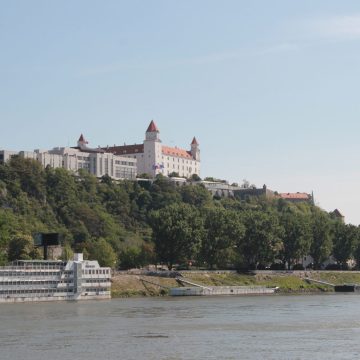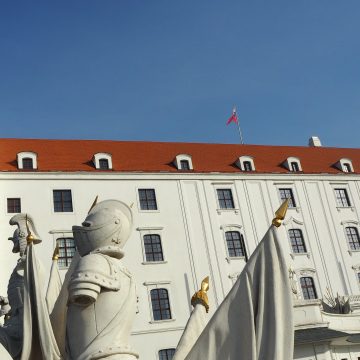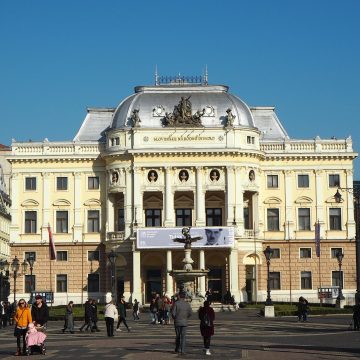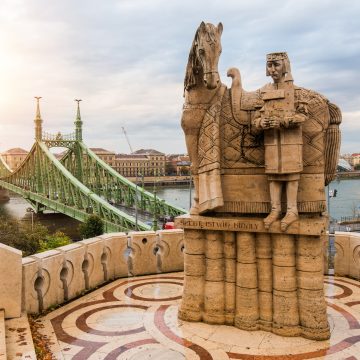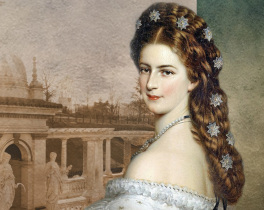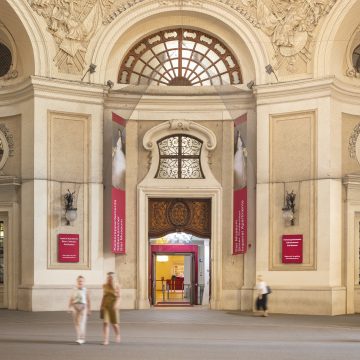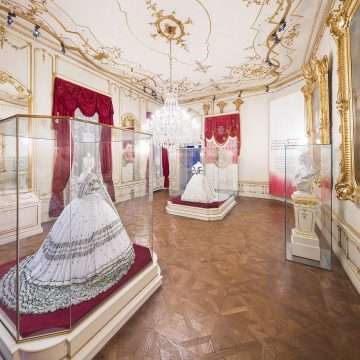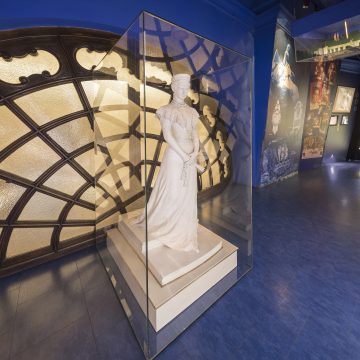Empress Elisabeth and the Danube - From Bavaria via Vienna to Budapest
Empress Elisabeth and the Danube - From Bavaria via Vienna to Budapest
When the Bavarian Wittelsbach princess Elisabeth boarded the Danube ship "Stadt Regensburg" in Straubing on August 21, 1854, it was not to start a pleasure cruise. No, the 16-year-old was on a bridal trip, or rather, she was on her way to the "wedding of the century" in Vienna - her own - because the Austrian emperor had fallen in love with his little Bavarian cousin in Bad Ischl the previous summer and immediately got down to business. Much to the displeasure of his mother Sophie and aunt Ludovika, who had actually seen Sisi's older sister in the role of the future Empress of Austria, after all, "Néné" had been prepared for such a wedding for years.
In contrast to the tomboy Sisi, who had actually only been taken along in order to distract her a little in Ischl and possibly set her up with Franz Joseph's younger brother, Karl Ludwig. Unfortunately, the maternal plans got out of hand very quickly in Ischl, because Franz Joseph, in a completely un-imperial manner, simply left Néné behind and fell in love with Sisi at the very first afternoon tea on the Ischl esplanade. By all accounts, the clumsy Sisi was a little embarrassed at first when dancing with the young emperor - especially when, after the famous "Cotillon," a popular Baroque dance, he unceremoniously handed her his bouquet of flowers prepared for the bride. It was immediately clear to all present, those from Vienna and those from Bavaria, that history had been made that evening, August 17, 1853, at the dance in Bad Ischl. Elisabeth was actually embarrassed by the whole thing at first. This was not to change for the rest of her life - she always hated court ceremonies.
She was not given much time to recover from the surprise and to prepare for her role as empress. The very next day, on August 18, they sat next to each other (!) at the emperor's birthday party, and on August 19 they were already allowed to speak to each other alone in private: The die was cast when the Empress Mother gave way to the 15-year-old Bavarian girl when she went into the church. At the latest then everything was clear to everyone, especially to the gawking foot people in Ischl.
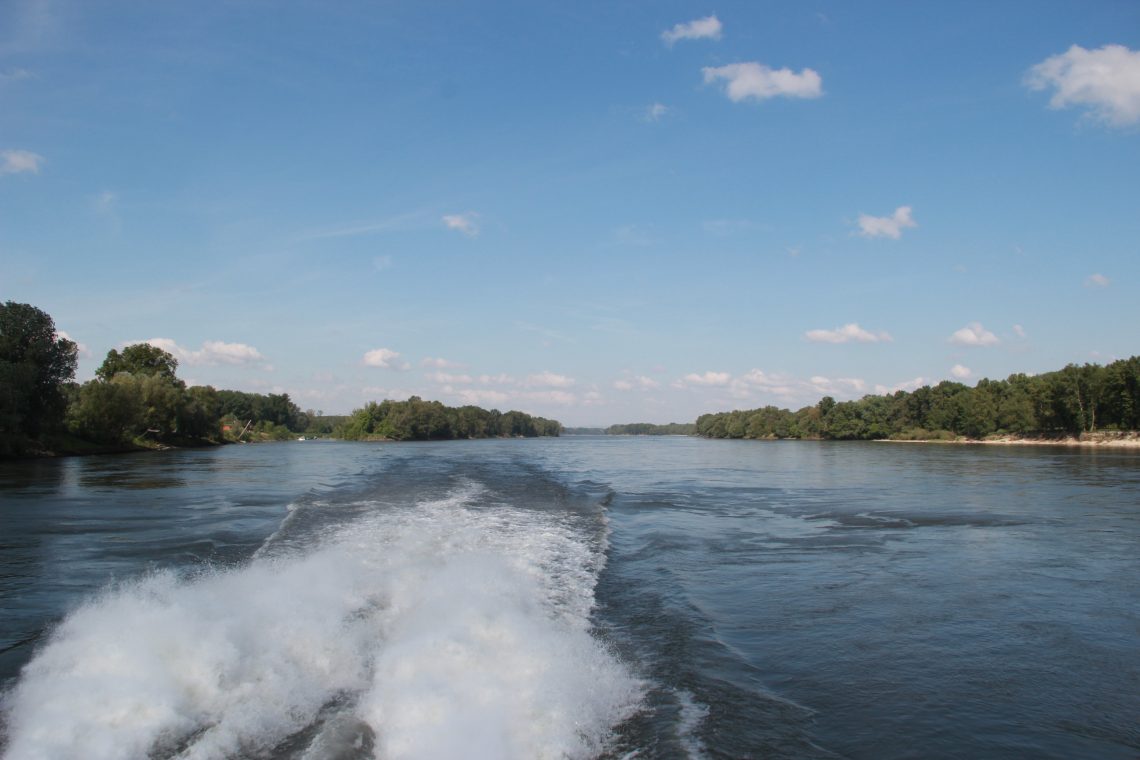
From those memorable days on the Traun in Ischl, however, we now return to the Danube - the river that was to bring Sisi and Franz Joseph together forever just under a year later. In the truest sense of the word. From Straubing to Passau it was still quite quiet, but in Passau there was already a first "reception", as it was called then as it is now: the state booths of Bavaria said "Pfiat di" (or something more official) and an Austrian delegation probably greeted Elisabeth and her entourage with a hearty "Servus" (or something). And in the evening, the huge convoy of ships docked in Linz.
There, the entire entourage with Sisi left the "city of Regensburg": The bridegroom had namely sent a new "express steamer" that would take the princess with her entourage to the Wachau and on to Nußdorf in Vienna. And he had also traveled to meet her - completely out of protocol, very unusual for Franz Joseph... Under the gaze of a crowd that was frighteningly large for her, Elisabeth had to greet her bridegroom. So embarrassing again! And Elisabeth was really in a very bad mood on this bridal trip on the Danube, if one may believe the Sisi biographer Brigitte Hamann (and one may do so without reservation). In a six-horse carriage it had gone in Bavaria to the departure point at the Danube and the parting from the old wild life in Bavaria and the brothers and sisters had been tearful. The enormous interest that was shown to Sisi everywhere on her Danube journey frightened and unsettled her.
The express steamer that the impatient bridegroom had sent was the largest and most luxurious passenger ship the Danube had ever seen at that time - Emperor Franz Joseph did not let himself be left out. The cabin for Sisi was lined with purple velvet, the 140 horsepower a minor sensation. Decorated with lush floral decorations, the ship resembled a floating garden on the Danube.
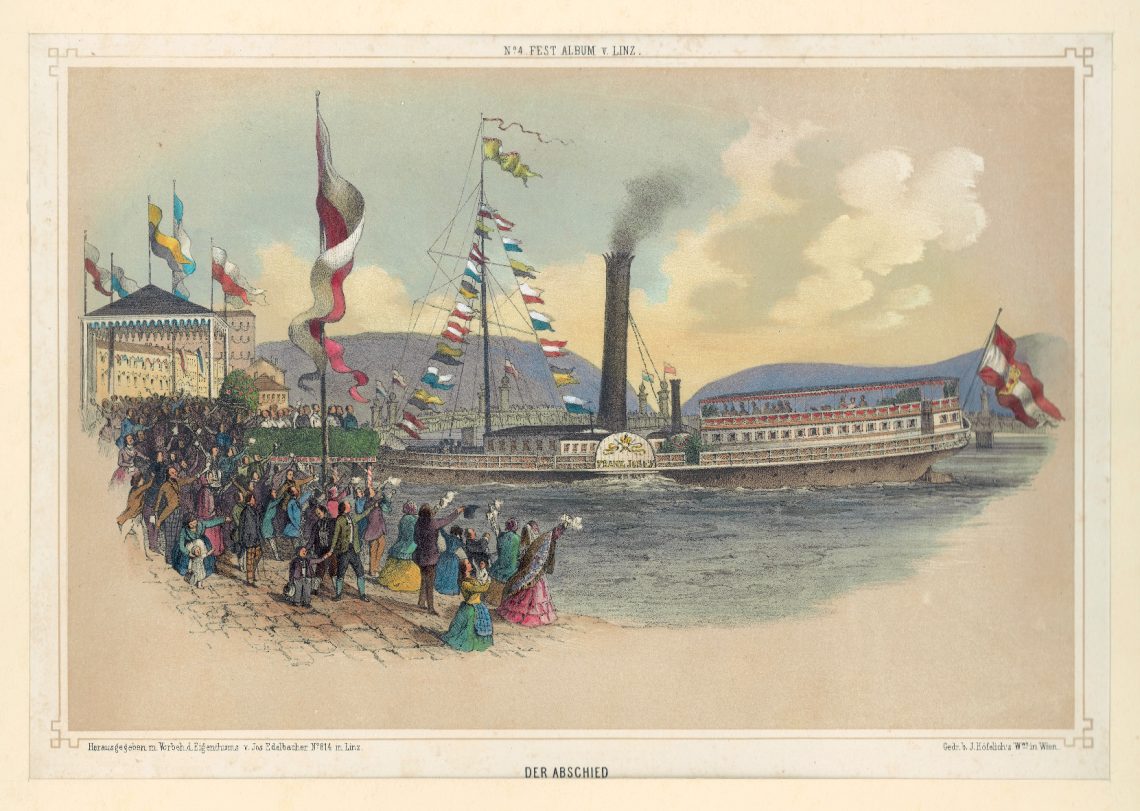
After spending the night in Linz (separately, of course), the emperor returned to Vienna already at 4:30 a.m. with the steamship "Austria" - because in the afternoon in Nußdorf near Vienna, he wants to officially welcome his bride right away - again under the cheering of the enthusiastic crowds. She starts "only" at 8 o'clock in the morning in Linz and is with the said egg steamer "Franz Joseph I" in the afternoon in Nußdorf.
The journey from Linz to Nußdorf is like a single river parade: in every town, people greet and cheer the ship that is taking the bride to Vienna. Elisabeth has to spend the entire trip on the upper deck, showing herself, being gawked at, representing, waving, being friendly. The "Hermine" with an Upper Austrian deputation follows the bridal ship on its heels, so to speak. The reception in Linz was nothing compared to the one waiting for them in Nußdorf - the Danube port in Vienna. Pompously with an immense triumphal arch, she had to go ashore under the eyes of the entire dignitaries under the thunder of cannons and the ringing of bells of all Viennese churches. Afterwards, in a carriage procession, they drove through the whole of Vienna to Schönbrunn.
And on the evening of April 24, 1854, she was already Empress of Austria - she had to travel to the Augustinian Church with her mother in a glass carriage, once again exposed to the gaze of the gawking Viennese. The "beginning of the end", Elisabeth would perhaps say today...
62 kilometers from Vienna lies the nearest metropolis of the former Danube monarchy: Bratislava. For a long time, Bratislava had been the capital of Hungary. At the beginning of the 20th century, there was even a streetcar line from Vienna to Bratislava, as can be seen in the current DONAU exhibition at Schallaburg Castle learns. From the castle's crown tower, one looks down on the Danube and has a panoramic view of three countries: Slovakia, Hungary and Austria.
Sisi must have traveled countless times by ship via Bratislava to Budapest - including that memorable trip in May 1857, when, against the express wishes of her mother-in-law, she traveled to Hungary with her two daughters to attend to lengthy representational duties: During their stay there, her first-born daughter Sophie died.
10 years later, however, in the spring of 1867, Budapest resembles Budapest on the Danube resembles a "permanent party," as one would say today: The four-day coronation festivities of Franz Joseph and Elisabeth are upon us. Once again, crowds of people flock to Buda not to miss the procession to Matthias Church. There the coronation of Franz Joseph as King of Hungary takes place. Franz Liszt's coronation mass is heard, the master himself is also there, but he is not allowed to conduct. But the secret protagonist in Budapest, indeed in all of HungaryElisabeth, whose intercession for the Hungarians is probably credited with the compensation. She spoke fluent Hungarian - much to the displeasure of her husband even with her own entourage and her most intimate confidante, the court lady Ida Ferenczy from Kecskemet - an affront in Vienna. At that time, the Sisi cult around the "Hungarian empress" probably arose in Hungary, which seems to be unbroken there to this day. The fact that she learned Hungarian of her own free will (while she failed in Czech) was more than a thorn in the side of the Viennese court - but Hungary and Budapest meant "freedom" for Sisi until the end of her life. Her closest confidante Ida, however, may have somehow infiltrated the court: according to biographer Brigitte Hamann, it is certain that she was also a confidante of the Hungarian liberals who were striving for the "Ausgleich" and that she reported to Budapest what was going on at the court in Vienna. Sisi's friendship with Ida had been meticulously planned for a long time, but as a Hungarian she remained a foreign body at court - all the closer she became to Elisabeth, until her death.
Throughout her life, Elisabeth remained an advocate for the special wishes of the Hungarians: she probably spent more days and nights at Gödöllö Palace near Budapest, which the Magyars honored her with after her coronation as Hungarian queen, than at home in Schönbrunn Palace. 136 rooms, 103 of which were living quarters, had the palace, where she spent much time with her children and riding horses. "Here you have your peace, no relatives, no one seks you, unlike Vienna where all the imperial baggage is! Here nothing oppresses me at all, I live here like in the village, I can go for walks or take carriage rides alone," wrote an obviously relieved Elisabeth to her mother in a letter. The Hungarians love her for it and it is also beneficial for the dual monarchy; Franz Joseph can thank his wife.
She gave birth to her daughter Marie Valerie ten months after the coronation, also in Budapest - the Hungarians were again delighted. By the way, Marie Valerie is said to have often complained much later that she always had to speak only Hungarian with her mother...
The empress's favorite place in Budapest is said to have been on the viewing plateau above the city, where a tower named after her stands today. Sisi and Ida are said to have been spoiled with sweets at the Gerbaud bakery, and the coffeehouse is still a fixture on every visit to Budapest. The devoted Ida Ferenczy, by the way, initiated the very first Sisi Museum in Budapest after Sisi's death, but it was destroyed during World War II. Today the Sisi Museum in Vienna in the Hofburg invites you to visit it. Or you can watch the "Sissi" movies with Romy Schneider for romantic reasons. You can read more about the "Myth of the Habsburgs and their traces along the Danube here.
However, the timeless biography by Brigitte Hamann on "Elisabeth. Empress against her will". "Against her will" - this could already be observed at the time of the bridal journey on the Danube...
All info subject to any Covid19 restrictions on locations!
Vienna
Bratislava
Budapest
-
- Visit Gödöllö Castle
- János mountain by chairlift to Elisabeth lookout tower
- The coronation church: Matthias Church
- National Museum Budapest: Sisi's shoes and the black jacket she was wearing at the time of her murder in Geneva
- The State Opera in Budapest: financed by Emperor Franz Joseph, and only "almost" more beautiful than the one in Vienna.
- Café Gerbeaud

